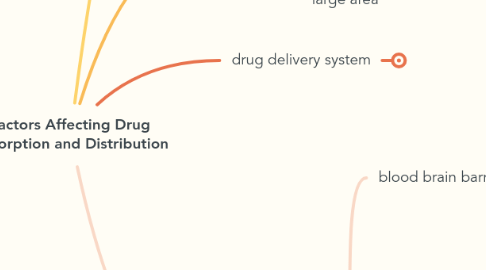
1. cell membrane
1.1. pinocytosis
1.1.1. vesicle formation
1.1.1.1. example: insulin
1.2. solubility
1.2.1. polar
1.2.1.1. nonlipid soluble
1.2.1.1.1. in extra cellular fluid
1.2.2. non polar
1.2.2.1. lipid soluble
1.2.2.1.1. crosses membrane easily
1.3. channels
1.3.1. passive transport
1.3.1.1. aquapores
1.4. carriers
1.4.1. passive transport
1.4.1.1. donot require energy
1.4.2. active transport
1.4.2.1. require energy
2. pH
2.1. weak acids in stomach absorb rapidly because of stomach's acidic pH
2.2. largest quantity of weak acids absorbed by intestine because of large area
3. drug delivery system
3.1. topical and transdermal
3.2. transmucosal administration
3.3. inhalational administration
3.4. epidermal administration
4. bioavalability
4.1. blood brain barrier
4.1.1. restricted aqueous bulk flow
4.1.1.1. because vascular endothelium of brain lacks
4.1.1.1.1. intracellular pores
4.1.1.1.2. pinocytotic vesicles
4.1.2. drug with high lipid solubility cross blood brain barrier
4.1.2.1. anesthetics
4.2. binding of drugs to plasma proteins
4.2.1. quinine bind to
4.2.1.1. beta globulins
4.2.1.2. acid glycoproteins
4.2.2. acidic drugs and some basic binds to
4.2.2.1. albumin
4.3. volume of distribution
4.3.1. total quantity of drug in the body is divided by concentration in plasma
4.3.1.1. heparin
4.3.1.1.1. large molecule
4.3.1.2. neuromuscular blocking agents
4.3.1.2.1. polar
4.3.1.3. ethanol
4.3.1.3.1. distribution in total body water
4.3.1.4. digoxin
4.3.1.4.1. bind outside of plasma compartment
4.3.1.5. anasthetics
4.3.1.5.1. bind to partitions into fats
